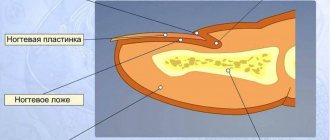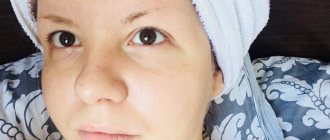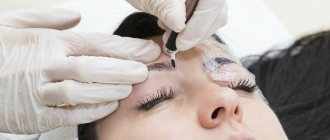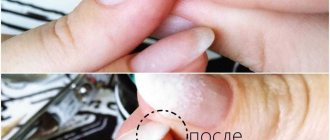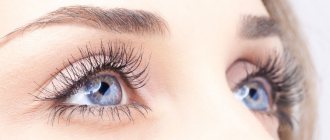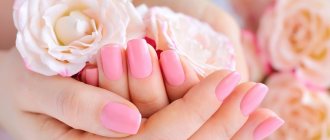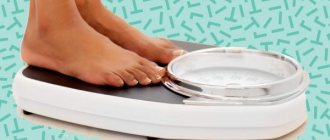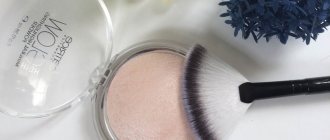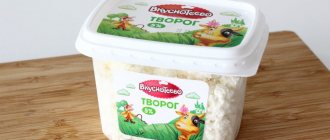What is a hardware pedicure
Hardware pedicure is a mechanical treatment of the skin of the foot, nails and toes using a special grinding tool with cutters and various attachments. The device, due to the rapid rotation of the cap, safely removes keratinized epithelium, corrects the nail bed, polishes the nail plates and removes cuticles.
The pedicure device has several operating modes, adjustable to different power and speed depending on the condition of the skin. After each session, removable attachments are treated with an antiseptic, ensuring absolute hygiene.
Hardware pedicure is a relatively new technology
It is not for nothing that this type of pedicure acquired such a name, because the main part of the process is carried out using a device. It consists of a base with a tip, which must be selected depending on the affected area. For example, a coarse tip is often used to remove excess skin from heels, while a softer one is needed to polish nails. The tips rotate during exposure, and their speed can also be adjusted.
Performing a hardware pedicure
It is the device that does the main work. The master only needs to direct the device to the desired area and adjust it so that it does not cause pain to the client, but at the same time gives good results.
In addition to working with the device, the master deals with coating the nails with coloring and strengthening agents, as well as applying protective cream to the feet.
Hardware pedicure is done on dry feet. The device works better on dry surfaces, so there is no need to pre-steam your feet.
Video - Features of hardware pedicure
Advantages and disadvantages of hardware pedicure
Visitors to beauty salons fell in love with hardware pedicure for its advantages:
- Painless . Despite the huge number of revolutions in the shortest possible time, the device operates very gently. After the procedure, there will be no feeling of discomfort either.
- Low risk of injury . The master can make a wound on the skin only if he incorrectly adjusts the device.
- Speed of procedure . The speed of operation of the device and the absence of the need to steam the legs allow the master to meet the deadline.
- Impossibility of infection . This provides virtually zero risk of skin damage.
- No contraindications . The only thing that can prevent you from creating such a pedicure is an allergy to the material from which the tip is made.
- Longevity of the effect . The skin is not completely exposed, so the process of formation of new cells is not enhanced.
- Productivity . After the procedure, your legs will maintain a neat appearance for a long time.

Technique for performing hardware pedicure
Although hardware pedicure has few disadvantages, they sometimes influence refusal of it:
- Relatively high price . This pedicure is more expensive than many of its analogues.
- Inability to carry out the procedure at home . The only exception is if you can purchase the equipment and get the hang of using it.
- A small number of pleasant moments during the procedure . Unfortunately, you will not be provided with a fragrant foot bath, and the process will go very quickly.
Features of hardware pedicure
The main feature of this treatment is the treatment of dry skin without prior steaming. The dead layer of epithelium is removed gradually in exactly the amount that is acceptable for the current condition of the feet.
Other features include:
- efficiency - different attachments not only tidy up nails, but also remove corns and calluses, leaving the skin smooth and soft;
- versatility - the device can be used even on sensitive skin without the risk of damage or fungal infection;
- the presence of a professional master - only a trained master can carry out the procedure correctly;
- therapeutic effect - hardware care eliminates cracks and ingrown nails.
The main differences between classic and hardware pedicure
Both classic and hardware pedicures are considered the most popular in beauty salons. Their differences are as follows:
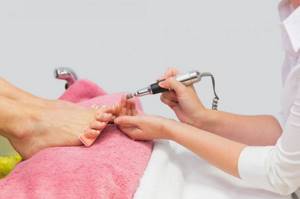
- Performance technique. For hardware care, you need a special tool with attachments, each of which performs a specific function. For the classic one, a set of tools is required, consisting of pumice, scraper, tongs, etc.
- Steaming. It is only necessary in the classic version. In a pedicure with a device, the skin is softened with special lotions and gels.
- Application of the trimming method. Only in the classical procedure is the skin cut off, increasing the risk of injury and infection with fungal diseases.
- Price. Hardware pedicure is much more expensive.
- Duration of effect. When treating feet with a sanding device, the skin remains smooth on average 2 weeks longer.
Which pedicure is the safest?
Let's start with this main question. After all, if you initially choose the right type of pedicure, this will increase your chances of having perfect heels significantly. At the moment, types of pedicure can be divided into 2 main groups:
Classic trim pedicure.
This is when the pre-steamed, rough skin of the feet is trimmed using special machines with a blade (scraper). After the procedure, the heels immediately become smooth and soft, but the skin grows back very quickly. And if the cut was not even and not very professional, then the growth will be a la “rags,” but that’s half the trouble. Each time the time between pedicures will decrease, because roughness will appear faster and faster. It’s hard to imagine why some girls prefer a trimmed pedicure, because a foot of any complexity and condition can be saved without circumcision, believe me! But, if someone still decides to have a classic pedicure, then it would be better to seek the help of a pedicurist, having first purchased the necessary professional tools. Then you will come to the specialist’s appointment with your own sterile accompanying materials.
European unedged pedicure.
This is a type of pedicure in which rough skin of the feet, corns and cracks are eliminated using special graters, milling cutters, scrubs, gels and other pedicure products. This pedicure can be done both in a beauty salon and at home.
It’s worth signing up for a pedicure office if you decide to get a hardware pedicure.
. This is when the rough skin is removed from the foot using special milling attachments that rotate very quickly. It's safe, but not suitable for everyone. Many girls find the very feeling of the cutter “going” along their leg unpleasant; it is difficult for them to endure, although this procedure cannot be called painful. This is rather an individual question.
But a regular unedged European pedicure
suits absolutely everyone. Let me immediately note that even the roughest and hardest heels can be saved with the help of a grater and gel for removing corns! The most important thing here will be the correct selection of a grater for the top and pedicure products.
European unedged pedicure is the safest type of pedicure!
You don't cut anything, which means you won't get hurt. There is no chance of getting foot fungus or any other disease. And also, the body does not perceive this place (foot) as a wound (this is exactly what happens during circumcision) and does not try to heal it faster, causing a rapid growth of new tissue. And thanks to the fact that you “rub” the foot, or in other words, “file down”, the skin becomes thinner over time and grows less.
So, if you want to improve your knowledge and skills in the field of pedicure and take care of your feet yourself, then for this you need:
- determine your foot type;
- purchase professional pedicure tools and products that are right for you;
- start using them.
Pros and cons of hardware pedicure
The advantages of such care include:
- Safety. During the procedure, contact with sharp objects is excluded, thereby reducing the likelihood of cuts and infection through them with infectious diseases.
- Sterility. Before work, the master treats his hands and all tools with antiseptic agents. If disposable devices are used, they are in a sterile bag and opened in front of the client.
- Lack of water. To soften the skin, keratolytic substances (ointments, creams, lotions) are used, which, in addition to their main function, also have a tonic effect.
- Lasting results. The attachments remove only the stratum corneum of the epithelium without damaging the healthy one. Regeneration processes do not start, and the skin grows slower.
- Speed of the procedure. Treatment of nails with the device is carried out relatively quickly.
- Painless. The rotation of the cutters and attachments feels like a light massage. Only very sensitive skin may experience slight discomfort.
- Minimal contraindications. Hardware pedicure is suitable for different conditions of the feet and is contraindicated only for people who are allergic to the components of metal attachments.
This method of foot treatment has significantly fewer disadvantages:
- high price in showrooms due to the cost of the device itself and consumables;
- if you don’t have a tool and/or experience working with it, you won’t be able to do such a pedicure at home;
- people with sensitive skin experience a burning sensation during the procedure.
Pros of trim pedicure
- Availability. It is not necessary to go to the salon; if you wish, the classic pedicure procedure can be performed at home.
- Budgeting. Trim pedicure is a fairly inexpensive procedure, as it does not require the use of expensive cosmetics, etc.
- High efficiency. Such procedures will return the feet to a feeling of smoothness and youth. The effect will be difficult not to notice and not to appreciate.
- A pleasant procedure. Almost everyone who gets a trimmed pedicure notes that this procedure brings positive emotions.
Cons of trim pedicure
- Possibility of contracting an infection. The objects that the master uses during the procedure are very sharp. Because of this, there is a risk of damage that can become infected.
- Short-lived results. Usually the effect lasts no more than 7-10 days.
- A very long procedure. If you decide to do a classic pedicure, then it is better to immediately be patient. And, of course, it will take a lot of time.
- Soreness. Removing rough skin with a sharp object is almost a jewelry job. An inexperienced technician may accidentally injure delicate skin.
- The skin seems more vulnerable. Since the entire rough layer of skin, which serves as a kind of protection, is removed, the feeling of “super-delicate” skin appears.
- Possible contraindications. They definitely need to be taken into account. Remember that those with very sensitive skin should avoid the classic pedicure procedure. Also, the procedure is unacceptable for diabetes mellitus, varicose veins, thrombophlebitis, etc.
Hardware pedicure
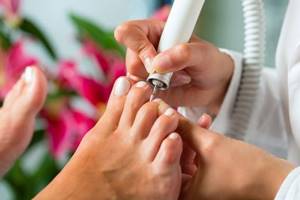
Its main difference from a trim pedicure is that almost all actions are performed using a special device. The master only directs the device’s actions to the required areas and regulates its operation. For example, to work with rough skin you need one attachment, and to polish nails - another. The master manually only applies nourishing cream to the skin of the feet and applies the coating to the nail plates.
Also, unlike a classic pedicure, this procedure is performed only on dry feet. There is no need to steam your feet, this will only reduce the effect.
For more information about hardware pedicure, watch the following video:
Advantages of hardware pedicure
- Safety. The use of special equipment eliminates the possibility of introducing any infection into the body.
- Long lasting results. The effect of the procedure is much longer than that of a classic pedicure. The reason to visit the pedicure office again will appear only after a month.
- Fast procedure. It will take very little time to restore beauty. If only because the steaming stage is excluded.
- Painless. Since the procedure is performed using a special device, the possibility of mechanical damage to delicate skin is eliminated.
- There are practically no contraindications. The only obstacle to the procedure may be a possible allergy to the material from which the nozzle is made.
- High efficiency. After the procedure, your legs look beautiful and well-groomed, and your skin becomes incredibly smooth.
Disadvantages of hardware pedicure
There are few downsides to this procedure, however, for some they may seem quite significant.
- No budget. The price for this procedure is significantly higher than for a classic pedicure.
- Unavailability. To be more precise, such a procedure cannot be carried out at home, since it requires special equipment and the ability to handle it.
- Simplicity of the process. There are few pleasant moments from the procedure, however, there are practically no unpleasant ones either.
Types of hardware pedicure
There are several types of hardware pedicure, differing from each other either in the method of processing cuticles or in the number of additional cosmetic procedures.
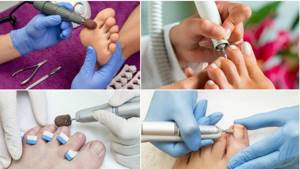
Classic pedicure
Classic treatment includes standard treatment of the sole of the foot, skin folds, fingers and toenails with rotating caps. Dead epithelium and cuticle are removed, a nail bed is formed, the surface of the nail is polished, after which a decorative or medicinal coating is applied to it. Finally, the leather is treated with finishing agents.
Unedged pedicure
Since all hardware pedicures are essentially unedged, this term is more of a nominative nature. During the procedure, the cuticle is not processed by the device, but is only moved with a wooden stick. To make it more pliable, the master first lubricates the surface with softening oils, and only then forms the nail bed.
This type of care prevents damage to healthy skin, but the effect does not last long: after just 2 weeks, the cuticles again look untidy and require treatment. If pushing back and softening with oils is carried out systematically, a cumulative effect is achieved - the cuticles become softer.
SPA pedicure
The essence of the procedure is relaxation after a hardware pedicure. When the treatment of feet and nails is completed, the following is done:
- foot baths with the addition of flavored oils, plant extracts, sea salts, thermal waters;
- peelings with natural scrub;
- various masks based on natural ingredients, vitamin complexes;
- relaxing massage.
Classic pedicure (trimmed)
Classic pedicure is a hygienic procedure that improves feet and nails. Classic pedicure is the prevention of various diseases. A classic pedicure is performed in several stages.
Classic pedicure step by step
- The first stage will be, as in any pedicure, disinfection. This usually goes like this: warm water is poured into the foot bath and a disinfectant is added to this water, and the feet are “soaked.” This procedure lasts 5-10 minutes.
- Next, the legs are taken out of the bath one by one and blotted with a towel.
- If there is old nail polish on your nails, remove it with a cotton pad and nail polish remover.
- Next, while the nails are soft (soaked), the nail is cut to the required length, carefully, with special pliers.
- Next, a small amount of a special softening agent is applied to the cuticle (side ridges).
- The next step is to treat the feet. This requires a special machine. It is best to work with the machine on a wet surface (sliding is better). This machine cuts off calluses. The movements of the machine should be along the cracks.
- After working with the machine, the foot is polished with a pedicure file. First, work with the harder (rougher) side of the file, then with the softer one. The file removes what could not be removed using the machine.
- Next, special tongs are used to remove the skin from the cracks that could not be removed using the machine. Anything that clings neatly is removed with tweezers.
- Then the entire foot is sanded again.
- Next, proceed to the nails. Use a damp cloth to remove any remaining stains from your nails.
- After wiping the nails with a napkin, the cuticle is moved back with a special double-sided tool and the lateral sinuses are cleaned. Impurities are removed from under the nail.
- Next, cuticles are removed with cuticle nippers and the front pads and side ridges are processed.
- After removing the cuticle, the free edge of the nail is filed. Most often it is given a square shape to avoid ingrown nails.
- The next step is to polish the nails with a special soft sanding file.
- Next, the nails are disinfected using a disinfectant and a cotton swab.
- Then a special antifungal agent is applied to the nails. The product needs to dry.
- Next, antifungal powder is applied to the toes.
- The next step is to apply a fixative to the nails.
- After the product has dried, apply cuticle oil and gently rub into the skin.
- The final step will be to apply anti-crack ointment to the heels and feet.
Indications for the procedure
In some cases, the choice between classic and hardware pedicure is a matter of health. Processing with cutters and attachments is necessary when:
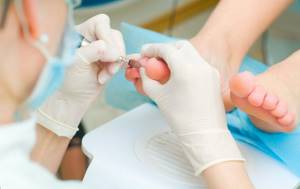
- hangnails - removing them with forceps will be difficult and traumatic;
- thin cuticles - ordinary tools damage it, causing pain for several weeks after a pedicure, and the device carefully removes it;
- uneven surface of the nail - polishing with attachments smooths out the bumpy surface, makes the thick nail plate thinner;
- diabetes mellitus – only a device can quickly improve the legs of people suffering from diabetes;
- damaged nails - special attachments correct any imperfections;
- ingrown nails - cutters not only treat ingrown nails, but are also considered its main prevention;
- cracks, corns, calluses - dealing with them manually is more difficult and takes longer.
Contraindications to the procedure
There are practically no contraindications to hardware pedicure. The only diagnosis for which it is prohibited is an allergy to the components included in the products used. You can try to select other materials, but the choice is not so large, and most of them have approximately the same composition.
For certain situations, a thin and weakened nail plate will also be a contraindication. Milling cutters may damage it during processing. However, experienced craftsmen know what attachments to use in this case and how to avoid injuries.
Milling cutters
The classic set of an experienced master for performing a hardware pedicure should contain 4 main cutters: a cone, a ball, a needle, grinders and polishers for feet of various levels of hardness.
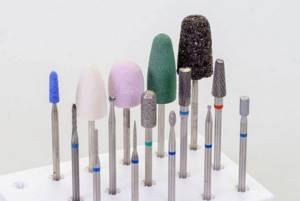
The rigidity of the cutter is determined by the cut. Three colors are suitable for pedicure – green, blue and red. Cutters with green notches and diamond coating are for rough skin, cutters with blue ones are the most popular for working with the skin of the cuticle, sinuses and sinuses of the nail, with red ones for working with the skin and sometimes the nail plate. They are considered soft. The yellow notch indicates the softest cutters with which you can safely work on natural nails.
How to choose a master?
The choice of a pedicure specialist is the main point on which the quality and comfort of the procedure depends. To find “your” master, you need to follow simple recommendations:
- Trust only proven salons with a good reputation, where it is clear at the entrance that sterility and hygiene are not just a sound.
- Be wary of home professionals who offer pedicures at ridiculous prices. Firstly, at home he receives many self-taught people who bought the device and immediately decided to make money from it. Secondly, too low a cost indicates the use of cheap, low-quality materials.
- Check that the specialist has documents confirming his qualifications - diplomas, certificates.
- Study reviews about the master on various resources. Both positive and negative reviews can be ordered online. If you visit several sites, you can get a more or less objective idea of the quality of services.
- Consult with friends. You should only trust those whose legs look the way you really would like. Some people tend to consider themselves competent in all beauty issues; their reviews should be treated with caution.
Also a good master:
- he cannot do only a hardware or only a classic pedicure - he knows all the methods and chooses the treatment method himself, based on the characteristics of the feet;
- does not follow the client’s lead and does not do something harmful - for example, it is impossible for a 35-year-old person to do “heels like a baby’s”, even if he tearfully asks (after this it will be painful to step on the foot for a week, and a new layer will grow in 2 times faster);
- does not impose unnecessary procedures and means - if he offers something, he argues why the client needs it.
You should feel comfortable in the company of the chosen master. A pedicure is not done in 5 minutes, so a good atmosphere will be the key to a pleasant time.
Device for hardware pedicure
The treatment of feet and toes is carried out with a special tool with various attachments, cutters and caps. The devices differ in technical characteristics:
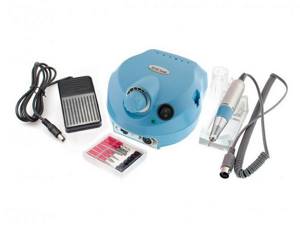
- Power. Devices with ratings above 35 W can withstand constant load and are suitable for pedicures, manicures, removing old coating, and cutting down artificial nails. Lower power is intended for occasional home use.
- Rotational speed. The number of revolutions per minute is adjusted by the master depending on the operation being performed, but the figure should not be lower than 25,000 rpm. Otherwise, even processing the cuticles will become a problem.
- Foot control. The pedal allows the master to free his hands during the procedure.
- Reverse. The nozzles rotate both clockwise and counterclockwise, performing their functions better.
Compact devices are available for home use, and more massive, powerful options for working in the salon.
Attachments for hardware pedicure
The attachments are used for skin, cuticles, natural and extended nails. They differ in diameter, rotation speed and rigidity. Nozzles are made from different materials:
- Ceramic. The safest ones are a mixture of abrasive and adhesive. There are coarse-grained (for removing keratinized epithelium on the feet), medium-grained (for processing cuticles), and fine-grained (for grinding the nail plate and skin ridges). Such attachments wear out quickly.
- Diamond. They last longer than ceramic ones. They are made from glue and diamond chips and vary in diameter. The hardness of the nozzle is determined by the color stripe on the rod: black - high, blue and green - medium, red and yellow - low.
- Metal. They are produced by applying notches to hard metal tips. They are used to remove a large layer of dead skin, file away thick coverings, and remove corns and calluses. They are convenient because they do not create dust.
- Silicone. Made of silicone and abrasive particles designed for grinding and polishing. Coarse-grained nozzles of dark colors are used to polish the sole of the foot, and medium- and fine-grained ones are used to polish nails.
- Natural. They contain fibers of plant materials that gently polish the nail and give it a natural shine.
Caps for hardware pedicure
The cap is a replaceable part made of rubber (inner part) and abrasive (upper part). The caps remove keratinized epithelium and polish the soles of the feet. They can be of different shapes:
- cylindrical;
- pointed;
- rounded.
Only dry skin can be treated with tips. The material cannot be disinfected after each use. The caps wash quickly and are inexpensive. The choice of a specific attachment depends on the condition of the client’s skin, the volume and type of work to be done.
Cutters for hardware pedicure
Milling cutters are a tip with several cutting blades and teeth, made of steel with the addition of abrasives. Its purpose depends on the shape of the cutter:
- ball - for caring for nail grooves;
- cylinder - for removing dead skin, calluses and corns;
- ellipse – for treating core calluses;
- cone – for treating ingrown nails and cleaning hard-to-reach places;
- disc - for polishing the nail plate, giving shape.
The final result depends on the quality of the cutters.
What skin types will you work with?
The choice of attachments and operating parameters of the device depend on the condition of the skin of the feet. The master himself assesses the amount of work and sets up the device. Each skin type has its own characteristics that affect the procedure.
Normal foot skin
Such feet are characterized by slight roughness in the heels and outer lateral part of the sole. Corns may form in the summer due to dirt and dust that gets into open shoes. In most cases, pedicure is limited to polishing; cutters are rarely used. The result lasts for at least 3 weeks.
Medium foot skin
A more problematic type, characterized by a tendency to dryness. It is considered the most common in our climate zone. The skin becomes yellowish due to the thick stratum corneum; if not properly cared for, calluses and cracks appear. The procedure takes longer and requires grinding. The effect lasts for an average of 2 weeks.
Problematic foot skin prone to damage
Due to increased dryness, the soles of the feet become covered with cracks, calluses, and become very flaky. It hurts to step on a person's feet. One treatment procedure is not enough. Every week and a half, you can restore the health of your feet with the help of the device and correctly selected attachments. The master also gives recommendations for home health improvement.
Step-by-step instructions for a hardware pedicure
The procedure takes a long time and is carried out in several stages:
- The treated areas are lubricated with an antiseptic to prevent infection.
- If the nail plates are long, they need to be trimmed with tweezers or scissors.
- A softening keratolytic is applied to the skin of the foot and rubbed in for several minutes until the hardened epithelium becomes pliable.
- If your feet are not clean enough, they should be placed in a bath of cool water so that they do not have time to steam, but are cleansed.
- The master puts on a mask and goggles.
- Use a paper towel to remove any remaining softening gel from your feet.
- The feet are treated first. First, a coarse-grained cap with an abrasiveness of 60/60 is taken, the rotation speed is set at around 10-12,000 rpm.
- Then the nozzle is changed to a fine-grained one with an abrasiveness of 100/100 for further polishing. Treatment is complete when the skin turns pink with a slight yellowish tint.
- The feet are moistened with water, and all excess is removed from them.
- Next the fingers are polished. A keratolytic agent is applied to the areas between the fingers and wiped off. The nozzle is changed to a cone-shaped one made of blue or blue ceramic, and the softened skin is processed.
- A pink or red cutter with a smaller grain size is installed, and the skin on the fingers is sanded.
- Special oil is applied to the cuticles and side ridges, then the latter are carefully processed at low speeds (up to 6,000 rpm).
- The nozzle is changed to a diamond-coated ball nozzle. The cuticle is polished (easily, without pressure).
- A felt cap is installed and the nail plates are polished to a shine.
- A natural-based moisturizer is applied to the entire surface of the feet.
What are the characteristics of hardware technology?
Hardware pedicure is an innovative approach to solving the problem of foot care. It is carried out mechanically using a special dry machine. There is no cutting of the cuticle, no water, scissors or nippers are used.
The main working tool of hardware technology is a set of various grinding attachments that replace hand scrapers and files. Each of them is designed to treat certain areas, performs its own specific function and is made of different materials.
It could be:
- Carbide metal;
- Diamond coating;
- Silicone;
- Rubber;
- Ceramics.
Each cutter that is inserted into the machine can rotate per minute at a speed of up to 50 thousand revolutions. Agree, a person physically cannot provide such an effect manually.
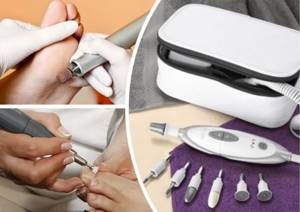
The essence of a hardware pedicure is that before starting the procedure, the master applies a softening gel to the skin of the patient’s feet. After the rough skin softens, the following is done:
- Treatment of feet with coarse abrasive and then grinding attachments. After which the feet are lubricated with a medicinal agent.
- Then the length of the nails is adjusted using pliers.
- A small nozzle is used to process the cuticle.
- Next, the surface of the nail plates is polished using a white stone nozzle.
- Fingers and interdigital space are treated with medium-diameter nozzles.
- The procedure ends with applying protective oil to the nails, covering them first with medicinal and then with decorative varnish.
What actions after the session?
Immediately after the procedure, you need to let your feet rest and absorb the cream. Then you can apply a decorative coating to your taste. If the specialist has given recommendations for home care, they must be followed. Evening foot baths and masks will not be superfluous, they will prolong the smooth effect and relieve fatigue.
Between trips to the salon, you can file your nails yourself, using a file from the edge to the center strictly in a straight line. It is undesirable to touch the corners of the nail - this can lead to ingrown nails.
Expert opinions on hardware pedicure
Nail service experts consider hardware pedicure an excellent alternative to trimming, since it does not damage the living layers of the skin, but only removes rough ones. Here is how Marina, a top manicure and pedicure specialist, speaks about the procedure: “Classic pedicure traumatizes the skin, after which the corns begin to grow again with a vengeance. Treatment with the device allows you to remove only dead epithelium, the smooth effect lasts many times longer. Regularity is an important point. If you do pedicures regularly, after a couple of months your legs will noticeably transform. In addition, hardware pedicure is great for pregnant women and people with diabetes.”
Subtleties of performing a trim pedicure
Photo of corns removal during a classic pedicure.
The step-by-step process looks like this:
- Before the session, the legs are lowered for 15-25 minutes. into a container with warm water, where sea salt, herbal decoctions, and aromatic oils are added. If the skin is rough, first apply an exfoliating scrub to soften the epithelium as much as possible.
- When the skin has softened, it is cleaned with a brush and pumice, first with large grains, then with fine ones.
- Then, using classic pedicure technology, they begin to process the nail plates. They are trimmed with scissors, tweezers, and filed with a nail file.
- The next step is to process the cuticles, which are pushed back with a wooden stick or carefully cut with nail scissors.
- At the end, the feet are again immersed in warm water, after which they are wiped dry, treated with a nourishing cream, and if desired, the nails are painted with varnish.
Pedicure ideas
The final stage of the procedure is coating. Since toenails grow slower than those on the hands, the decor of the nail plates will please its owner longer. A few ideas for a beautiful pedicure:
- monochromatic classics emphasize style; bright colors are especially popular in the summer;
- the matte finish goes well with various nail art techniques on several fingers - stamping, “broken glass”, “cat’s eye”, etc.;
- French and lunar pedicures always look neat and sophisticated, suitable for any time of year;
- thematic designs such as marine style, floral patterns, geometric shapes, fashionable prints speak of the originality and good taste of their owner;
- rhinestones, sparkles, and stones add luxury to the look.
Hardware pedicure is a good way not only to tidy up your nails, but also to improve the health of your entire foot. Safety, efficiency, speed of implementation - thanks to these characteristics, this type of care wins over the classic trim pedicure.
Choosing between pedicure techniques
Which pedicure technology is better, hardware or classic? The answer suggests itself if you consider the following aspects:
- when maximum safety, painlessness, and complete protection against infection are needed, it is worth doing a hardware pedicure;
- If you have problems with the heart, blood vessels, or diabetes, there is no better hardware method. The same applies to cases where there is thrombosis, varicose veins, or fungal diseases of the legs.
What to prefer, a classic trimmed pedicure or another is a personal matter for everyone, but one thing is worth remembering for sure. When visiting a beauty salon, pay close attention to the qualifications of the master. In this case, the sessions will bring maximum benefit to the body and moral satisfaction.
